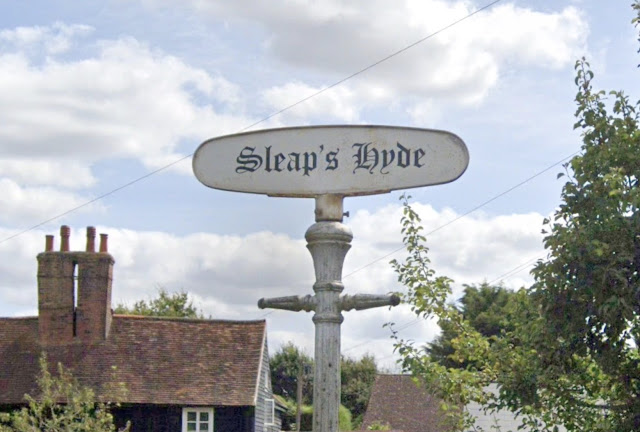Back in 1921 was posted a summary of the District Council's Conservation Area (CA) character statement for Sleapshyde, one of just three CAs in our East End. (See this link). This week I have returned to Sleapshyde as there was one element largely missing from the post from 2021: The Village Green.
Of course, we all have our own interpretation of what such an open space might look like. In fact, I'm not sure it would be appropriate to label Sleapshyde Village Green as open space. Certainly it is at the focus of three converging roads; from the north and the Plough PH; from the south and the imposed dualled carriageway; and from the south-west giving access to Smallford Lane via the post-World War Two housing, much of which was erected by former builder Ernest Stevens. And where they meet is a roughly semi-circular grassed area which you might also describe as a form of roundabout – but a tiny one and not very round. Vehicles can often be seen parked on the outside of two of the converging roads, especially on the pond side.
 |
| The well has been sealed and the pump – minus its operating arm – would continue to enable water to be drawn. |
 |
| The first modern lighting pole has begun to carry signs, and warn of Sleapshyde's Neighbourhood Watch. |
Probably the busiest time for this little green was during the period before modern houses arrived, and before a piped water supply. For the green contained a well, which was later capped and converted to a manual pump. The pump is still present (nicely green) although its pump arm has been removed so that water cannot be taken from the well. The second improvement arrived with the metalling of the road surfaces for the green became hard edged with granite kerbing stones.
 |
| The old lamp post serves to carry its share of traffic signs, and in spite of the kerbing, drivers still manage to mount onto the grass. The first modern lighting in an early post-war design. |
Next to arrive was street lighting: a single lamp standard, which may, from its design, have been from the 1920s or 30s. No other lighting had been brought to the village until the post war housing was put up, and no lighting crept along the road to the Plough or along the narrow farm lane towards the bypass. When the first of the modern street lighting arrived, a tall 1950s lantern style, and placed at the opposite end of the green, the decapitated original post was repurposed because until then there was nothing to suggest this was the village of Sleapshyde. An oval-shaped metallic sign with the name of the village printed in medieval style script (similar to Agincourt) on both sides, straddled the top of the post. Intriguingly, the descender ("tail") of the letter p is missing on one side! I notice from Google Streetview that the sign plate was missing for a while a few years ago, but was later restored.
 |
| One side of the village sign ... |
 |
| ... and a "sleepy" p on the other. |
The electricity people made a more recent visit to the green to remove the 1950s street light and replace it with a rather short post-and-arm with an LED head. But by this time the telephone people (presumably Openreach) had also made a visit with a timber pole for phone wires to keep the street light company.
It may have been the parish council which determined that a little greenery would go very well on the green, and so planted a tree, supported by a stake. This has grown considerably in recent years such that it is difficult to spot the former pump – which is, of course, also green.
It is probably barely twenty years ago when the first sign made its way onto the green. So now there are two footpath finger signs attached to the present street light post. Actually, there is now a third to guide visitors to the Plough restaurant and public house. On both sides of the village sign post are traffic signs for the benefit of motorists; there's a circular "keep to the left" arrow, and on the back of that is a rather larger square plate announcing "no through road".
You would have thought that is quite sufficient for one little green space, but the Plough had a more-or-less permanent A-board announcing selected menu items. More recently they thought the venue wasn't sufficiently identified, so a low-growing direction sign – double-faced of course – has been driven into the ground at the street lamp end.
Of course we haven't quite finished, because where there is an opportunity for taped posters which can be wrapped and taped around metal posts someone will tearfully announce a missing cat, tell the locals about a meeting in the hall, or remind residents of a local event or, on behalf of the council, issue a planning notice. All life is there.
A village green is, after all, a multi-purpose space, even one as small as the one at Sleapshyde.













































